The role of the greenkeeper / groundsman is constantly changing, especially in recent years with the advancement and better understanding of the science and biology of nature. More and more turf professionals are becoming interested and more aware of the benefits of collecting and recording data about their facilities. Since completing my Master’s degree at Cranfield University, I myself now have a better understanding of relationships between plants soil and water.
Last week I took the opportunity to attend one of the popular STRI Research open days at their Bingley research centre, where several leading companies were on hand to tell us of their latest developments and trials of new products and services.
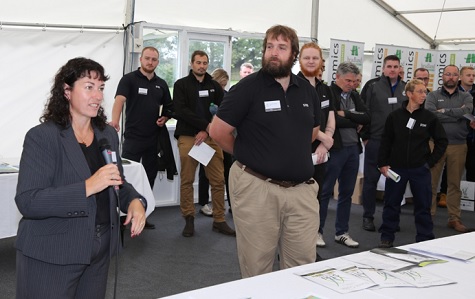
At Bingley the STRI manages multiple research projects and product trials each year, designed specifically to suit each individual sports surface. Their knowledge and expertise is founded on more than 80 years of dedicated research into improving the playing qualities of sports surfaces all over the world.
STRI works with a number of companies each year on Research & Development projects for the sports turf industry and had invited a selection of these companies to support this event, based on their current focus on research and their investment to help improve the future quality and management of sports turf.
The companies attending and supporting this year’s event were Airter, Aquatrols, Bayer, Headland Amenity, ICL, Sherriff Amenity and Syngenta.
There were seven separate demo areas called ‘stations’, which focused on individual products, techniques and/or machinery that have been developed to support the effective management of sports turf.
Attending the day were over 150 grounds professionals representing a plethora of sporting facilities, each of which were put in groups of around 15-20 and sent around the seven company stations during the day.
The day began with a welcome from Ruth Mann who said, “STRI Research Days are an excellent way to gain insight into the latest developments and thinking on tackling current and future turf management issues.
“STRI Research Days offer turf managers a unique opportunity to network with, not only fellow turf managers, but to view and discuss the latest developments in turf maintenance with turfgrass scientists and industry professionals. This is reflected in feedback from previous events, where those attending have valued learning about what is new and upcoming in our industry and to have an opportunity to discuss these ideas.”
STATION A AIRTER :-airter® light 14160 by NOVOKRAFT Ltd, Switzerland. Introducing the world’s first continuous pneumatic soil loosening machine, airter®, which improves soil structure and plant health immediately and sustainably.
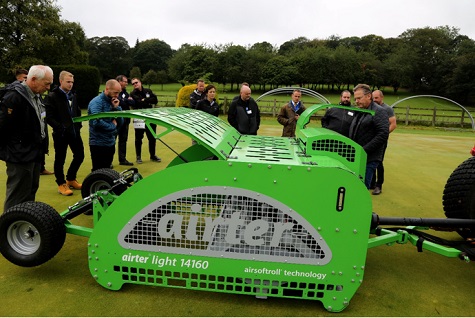
We are all aware of the problems compacted soils cause and in recent years we have seen a steady stream of new pneumatic / compressed air soil relievers coming to market, however this one has only recently come into the country via the sports turf contractor Fineturf. We were show around the machine and had the chance to see it working, the makers claim that the world’s first continuous pneumatic soil loosening machine airter® improves soil structure and plant health immediately and sustainably. Using an array of different length tines gives the machine the flexibility to inject air into the rootzone at depths between 75mm- 275mm.
The machine also allows you to vary the air pressure between 2-9 bar. With a number of these machines being widely used in Europe in sports stadiums and golf courses, the makers also claim they have witnessed some additional benefits from the use of this machine in terms of controlling chafer grubs. It would seem the blast of air kills any grubs within the operating depth.
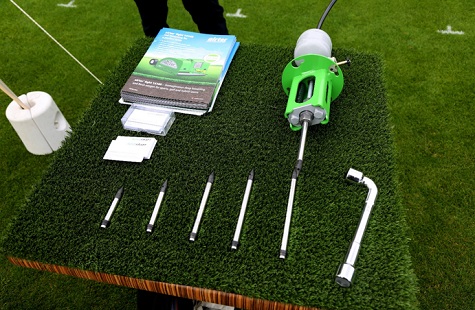
The machine has been well thought out and provides us with another tool in the armoury to decompact soils at depth. I’m not quite sure though whether it has the durability to cope with aerating stoney soil.
Field of application: Golf (greens and fairways), football, rugby, cricket, American football, baseball, horse sports and much more.
Our next station was STATION B ICL & SYNGENTA :-The science of ITM solutions. Presenting the results of new Integrated Turf Management (ITM) research and how this is providing practical solutions for greenkeepers and sports turf managers to create consistently better turf surfaces.
ICL Technical Manager, Henry Bechelet and Syngenta Technical Manager, Glenn Kirby, the dynamic duo, gave us a fascinating talk on the research and results they found after a series of ITM trials at Bingley.
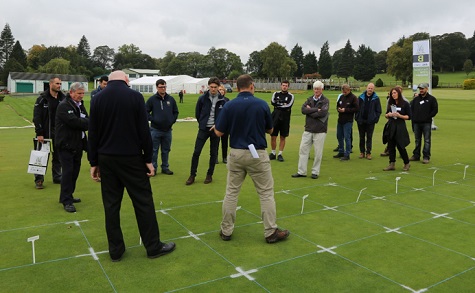
New tools and techniques have been proven to enhance turf health and minimise the effects of stress. Key learnings from STRI ITM trials include:
- The importance of nutrition for maintaining plant health
- Pre-stress conditioning to aid fast recovery
- Managing light for season long growth
- The positive influence of moisture management, including dew dispersants and wetting agents
Both ICL and Syngenta invest heavily in science R&D to fully understand the workings of any new products. Now, ITM research ensures they can be used in the most effective and practical ways, alongside other turf management techniques.
This was clearly demonstrated with a series of graphs shown on the stand.
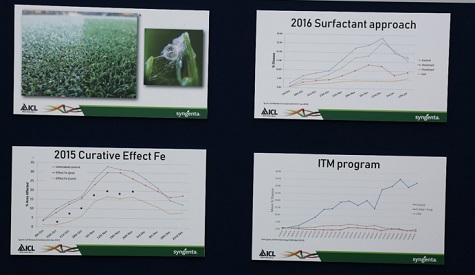
Each component on its own can help slow the rate of development of disease, but when used together as part of good ITM practice, the combined affects achieve a greater significant overall reduction in disease activity and ensure the best possible results from every fungicide application.
ITM provides a better way of meeting environmental responsibilities and complying with increasing rules and regulations regarding chemical application. It also helps to maintain healthy turf through long-term sustainable management.
I particularly enjoyed the way they demonstrated the percentages of disease that could be found on sports turf using, some red discs that graphically indicated 1% 5 % 20% and 45% disease attacks.
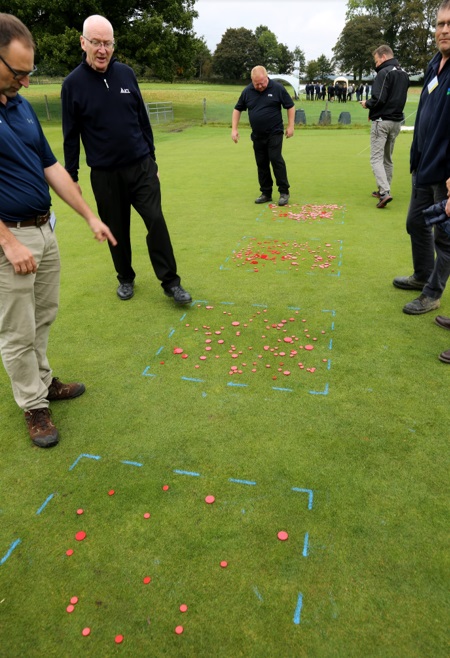
STRI ITM research has also been fundamental in underpinning the components of new Turf Rewards initiatives. The Fortnightly Mix, for example, utilises the proven performance of Vitanova Stressbuster nutrition, alongside Qualibra wetting agent, Primo Maxx II PGR and Ryder pigment.
We then moved onto STATION C HEADLAND AMENITY :-Non-pesticidal disease management. Presenting a holistic approach to autumn disease management using targeted applications of preventative fungicide in combination with plant elicitors and hardeners.
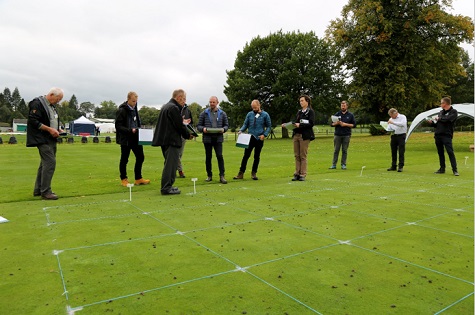
Headland Amenity has pioneered a multi-layered, straightforward and, above all, cost-effective approach to Microdochium nivale management using targeted applications of preventative fungicide in combination with plant elicitors and hardeners.
This approach is constantly evolving, improving its efficiency based on successful end-user feedback and backed up by independent data from trials conducted at STRI since 2007.
Changing autumn and winter weather patterns Over the last 10 years, undulating patterns in the flow of the jet stream have allowed extreme weather conditions to develop and persist, sometimes over months at a time. From October 2018 to March 2019, there were 12 separate warm air peaks across Central and Southern England associated with air temperatures in double figures, high humidity and therefore high disease pressure from Microdochium nivale.
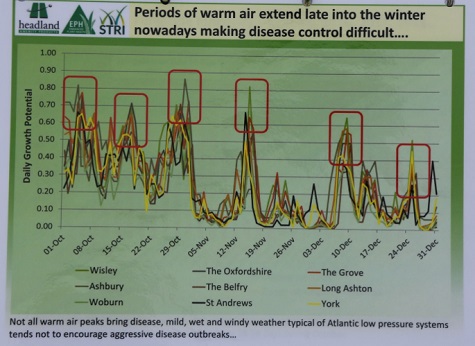
During three of these incidences of high overnight air temperature, humidity and extended periods of leaf wetness, Microdochium nivale was extremely aggressive and end-users saw new patches of disease develop rapidly across turfgrass surfaces. Once established, these patches became reactive later on during the winter.
Headland Amenity’s strategy relies on a two-tiered approach to autumn disease management. Firstly, a preventative fungicide programme is put in place. The aim is to prevent a high fungal population from establishing during October, November and December. End-user experience and STRI trials have confirmed that if this does occur, the outbreak is very difficult to control for the remainder of the winter and scarring will still be evident the following spring, affecting playability and surface integrity.
The second tier of the approach is based on non-fungicidal product technologies, namely plant protectants, elicitors and biostimulants. Plant protectants Formulated to ‘modify’ the surface leaf environment and thereby make it more difficult for pathogenic fungi to colonise and enter the grass plant.
Headland products in this category, trialled at STRI, include Seamac Proturf Fe, Liquid Turf Hardener, the high potassium liquid fertiliser – Protec K and our recently introduced Mantle formulation. In the 2019 trials we will also be evaluating a new formulation code-named PPT114 that has shown promising results on in vitro disease populations and in last year’s STRI trials.
Plant elicitors Formulated to trigger the natural defence mechanism of the plant, (SAR – Systemic Acquired Resistance) and thereby encourage the plant to grow better in the presence of a pathogen.
A strategy to manage Microdochium nivale should not be based on fungicide alone, as the severity and impact of this disease is also affected by the health of the grass plant, its level of nutrition, cultural practices and the presence of plant leaf moisture (Dew and Guttation Fluid). In addition, legislation has resulted in fewer and fewer choices of fungicide active ingredients following the recent loss of Iprodione, Propiconazole and Chlorothalonil. It therefore makes sense to look at a holistic approach to autumn disease management.
For autumn 2019, Headland will be introducing a well-recognised plant elicitor, salicylic acid, into its new Turfite formulation and in addition utilise Harpin plant elicitor within the Mantle and PPT114 formulations.
Biostimulants: Lastly, to stimulate the plant to grow away from the disease and thereby enhance recovery, Headland Amenity use a unique phosphite formulation called Turfite Elite. Recent research has identified a plant physiological process linked to the application of phosphite which could enhance the ability of a plant to grow under the effects of abiotic and biotic stress. As mentioned above, Headland Amenity are introducing a new Turfite formulation – Turfite Elite in these trials utilising potassium phosphite, salicylic acid and a nano-uptake enhancer to optimiseplant uptake.
The above approach is combined in the successful 20-20-30 tankmix of Turfite Elite, Liquid Turf Hardener and Seamac Proturf Fe to help reduce disease populations with 2018/19 trial results
We then broke for tea, enabling delegates to catch a breath and take the opportunity to network with one another. I managed to catch up with some notable industry people such as Professor John Moverley from the Amenity Forum, David Robinson, Skipton Castle and Andrew Clarke, Shelton drainage.
STATION D SHERRIFF AMENITY:- I was particularly looking forward to hearing Sheriff’s presentation, as the previous evening I had been introduced to one of their speakers David Harrod from Badger Crop Nutrition who has spent the last 30 years developing new fertiliser products and now recently been involved with a new project to recycle batteries into a usable fertiliser product.
Sherriff have always been proactive in providing and bringing innovative new products, ideas and solutions to market without out doubt they certainly had three interesting trials going on that offered some solutions to an ever demanding and changing environment.
The two that stood out for me was the Battery recycling one and the opportunity to convert NOx Gases (Nitrogen oxides NOx) poisonous gases into a usable turf fertiliser.
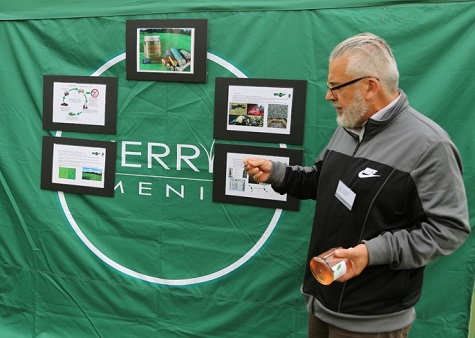
David’s talk was about his work and involvement with the development of ZM-Grow which was being trailed at the STRI Plots. Using unique technology developed by Tracegrow in Finland, Manganese and Zinc are extracted from used alkaline batteries and processed into premium-standard Sulphate based liquid foliar fertiliser. Tracegrows ZM-Grow fulfils all requirements of EC legislation concerning fertilisers and is approved for use as an organic fertiliser under EU regulations. Not only is ZM-Grow proven highly effective but it is also the world's most ecological Zinc, Manganese and Sulphur based fertiliser product in which the key micronutrients nutrients are recycled. To ensure quality, purity and consistency every batch is monitored and overseen by 100% external independent quality control certified laboratories. ZM-Grow™ has been certified for organic use in the UK by OF&G (Organic Farms and Growers).

STATION E AQUATROLS :- Paul Lowe and his colleagues were on hand to talk about some of the new Aquatrols trials being undertaken and the products they have developed from previous trials with the aim of Strengthening the plant and enhancing soil health through the novel combination of next generation soil surfactants and microbial blends Showcasing the latest trials on plant health supportive solutions, biopesticidal candidates and novel soil surfactants.
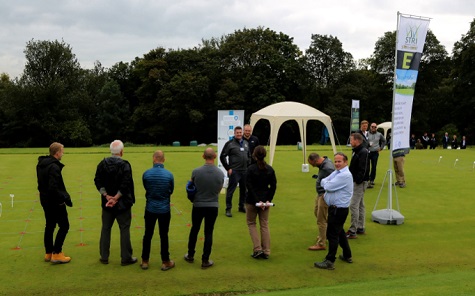
The concept: Turf managers are under escalating pressure to sustainably maintain high quality turf year-round; an undertaking that is further complicated by a rigid regulatory environment, in which pesticidal inputs have been rationalised and will continue to be progressively restricted. To cope with these issues, it is imperative to adopt an integrated approach to modern turf management, one that considers prevention, stress reduction, water/ nutrient use efficiency and plant health enhancement. This scenario requires that groundsmen and greenkeepers employ a full spectrum of plant growth technologies, both biological and conventional.
Investigating these technologies is important because the need for superior playing surfaces, whilst reducing environmental impact, is ever increasing.
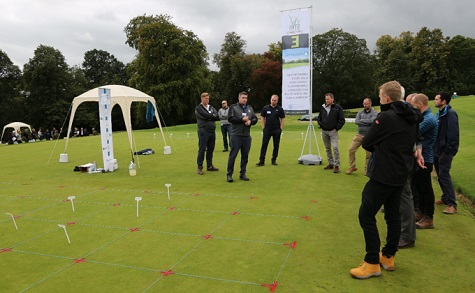
Their trails are set to determine the efficacy of EXPERIMENTAL concentrated blends of bacterial and fungal spores, combined with specially selected micronutrients and soil surfactants, on plant health. Experimental assessments will include turf colour and density, soil moisture, root biomass, rootzone microbial composition, and disease incidence over a 60-90 day period under field conditions.
STATION F BAYER CROPSCIENCE :- Turf stress a key focus for Bayer in 2019, showcasing two trials aimed at informing greenkeepers’ decision making, based on the issues they face today. The first trial shows how certain products can help mitigate the negative effects of summer and the second puts preventative and early curative fungicides to the test.
Dr Colin Mumford, Bayer technical manager, explained the first trial aims to show how certain products can help mitigate the negative effects of summer stresses such as heat, drought, wear and diseases such as anthracnose.
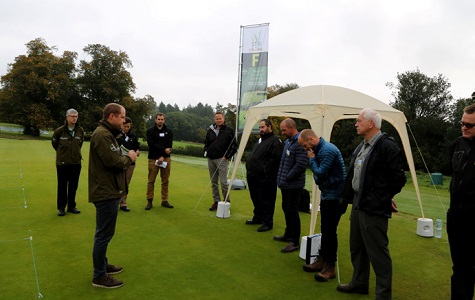
“A variety of different fungicides and plant health beneficials will be put to the test, including Bayer’s Stressgard® formulated products, growth regulators, wetting agents and a pigment.
“It will be a like-for-like comparison and turf quality, colour and disease prevalence will all be measured throughout the season. At the end of the trial there will also be destructive analysis of the turf including evaluations of root mass and length, along with physiological changes in the grass plant,” says Colin.
“The results of this trial will help turf managers make more informed decisions around summer turf stress factors, which are becoming more of a problem as summers become hotter and drier.”
The second trial puts preventative and early curative fungicides to the test. “This trial aims to establish the effects of these fungicides on anthracnose,” he says. “We will be trialling two of our preventative fungicide products alongside a number of other early curative products.”
Colin adds that they will also be testing different intervals of treatment and application rates to identify the optimum timing and application rate for effective control of anthracnose.
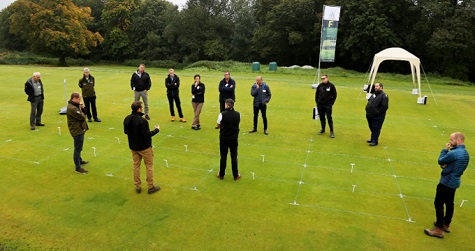
“We’ll be looking at application intervals of 14, 21 and 28 days and trying to understand which is more effective. “Application rate will also come into this. The trial will test if it’s possible to reduce applications to half rates and increase the number of applications. For example, half rate applications at 14-day intervals compared to a full rate at 28-day intervals.
“This will enable us to provide turf managers with accurate information on how to get the most out of disease programmes,” he says. For the first time, Bayer showcased two trials at the STRI research day - with both aimed at informing greenkeepers’ decision making, based on the issues they face today.
“We’ve done a lot of this research in the USA but as they can use slightly different management techniques, we felt it was important to invest in trials that provide a UK data set which can be readily applied to the UK climate and management practices.”
STATION G STRI - Turf management 4.0 Exploring some of the ways in which 21st Century turf management can be linked to other aspects of the sports facility.
Turf surfaces have historically been seen as the ‘bit of green’ in the middle of a sports facility, generally with no questions asked, unless something goes wrong or the home team doesn’t perform! With a significant increase in turf quality over the last 20 years more attention is now being paid to how turf surfaces can be linked into the management of the sporting facility, and no longer being seen as just the bit of grass to play on.
At this station we were given an update on some of the methods we can now implement to safeguard and recycle valuable water resources. Gone are days when you simply allow water to be drained away. Today most modern new stadium builds will need to be more accountable for the use of water. This is done by the building of various water storage tanks within the structure of the pitch or roof space. Collecting and reusing water is essential to protect this valuable resource. Green roofs with water tanks below are becoming the norm in new city landscapes.
We then then had a demonstration of the use of a Clegg hammer to record Turf Hardness. This device has been used for a number of years to define turf hardness at football training grounds, with the aim to prevent injuries to players. Leicester City physios have been recording turf hardness for many years and now have a set figure that the groundmen at the club should achieve to ensure the training pitches do not become too hard and cause injury to the players.
I, like all those who attend these STRI open days, find it very rewarding to see and hear the latest developments in Turf Science and the development of the many new products that come to market after these very valuable product trials.
I’d like to thank STRI for inviting me and look forward to seeing the results of the next round of independent product trials.